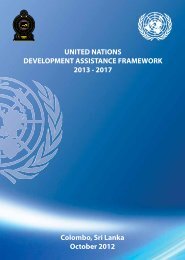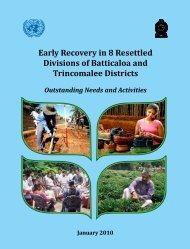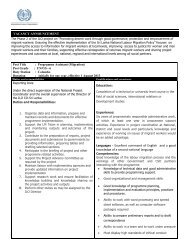Sri Lanka Human Development Report 2012.pdf
Sri Lanka Human Development Report 2012.pdf
Sri Lanka Human Development Report 2012.pdf
Create successful ePaper yourself
Turn your PDF publications into a flip-book with our unique Google optimized e-Paper software.
Both Nuwara Eliya and Badulla have high proportions<br />
of their population living on estates, where poverty rates<br />
are high. Nearly half of all women of reproductive age on<br />
the estates do not have even a primary education, and 30<br />
percent of women are malnourished. 60 Most districts with<br />
high levels of child malnutrition in 2009 had relatively low<br />
female educational outcomes. 61<br />
Several government initiatives are in place to arrest<br />
malnutrition. Some, such as the Threeposha supplementary<br />
feeding programme, have been operating for a long time.<br />
Yet improvements have been limited, due partly to the fact<br />
that raising nutrition levels requires concerted efforts on<br />
many different fronts (Box 3.1). Frequent infections and<br />
hard labour, for example, can also cause malnutrition, but<br />
are unlikely to be addressed by feeding programmes. More<br />
recent malnutrition initiatives are more intersectoral and<br />
likely to have a greater impact. They follow the National<br />
Nutrition Policy and Strategic Plan of 2010, which seeks<br />
to bring together many different stakeholders to address<br />
malnutrition. 62<br />
Box 3.1<br />
The Influence of Socioeconomic Factors on Child Nutrition<br />
There are considerable disparities in child nutrition across<br />
socioeconomic groups that favour the better-off in <strong>Sri</strong> <strong>Lanka</strong>.<br />
A child belonging to the ‘poorest’ socioeconomic quintile is<br />
three times more likely to be underweight than a child in the<br />
richest quintile. The prevalence of maternal malnutrition and<br />
low birth weight babies is four times higher among the lowest<br />
socioeconomic group compared to the highest. Babies<br />
with a low birth weight are twice as likely to be underweight<br />
children as babies with normal birth weight. A mother’s<br />
nutritional status and education have strong impacts on a<br />
child’s nutrition and birth weight. A malnourished mother<br />
may, for example, be less successful at breastfeeding and<br />
caring practices that are vitally important for a child’s health<br />
and proper growth. 1 A child whose mother is educated below<br />
primary level is twice as likely to be underweight as a child<br />
with a mother who has completed senior secondary level<br />
education. Poor education reduces the ability of mothers to<br />
benefit from awareness programmes about family health<br />
and hygiene, among other effects.<br />
Prevalence of Underweight Children and Underweight Babies by Mothers’<br />
Socioeconomic Characteristics<br />
Sources: 1 Jayawardena forthcoming and Smith et al. 2003.<br />
Chapter 3 Bridging <strong>Human</strong> <strong>Development</strong> Gaps: Health 39






